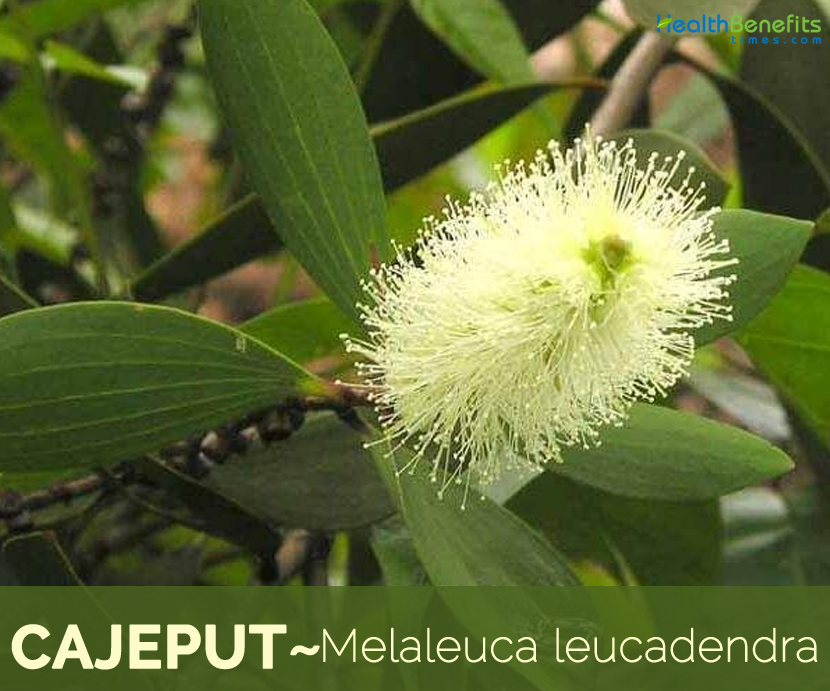| Cajeput Quick Facts | |
|---|---|
| Name: | Cajeput |
| Scientific Name: | Melaleuca leucadendra |
| Origin | Indonesia, Papua New Guinea, Northern and western Australia. |
| Colors | Grey-brown |
| Shapes | Woody capsule that is short, cylindrical 3-4 mm by 4-5 mm, hard and persistent |
| Taste | Pungent, sweet |
| Health benefits | Treat rheumatism, gout, neuralgia, acne, nasal congestion, sinusitis, toothache, chilblains and skin diseases. |
Plant Description
Cajeput is a moderately fast-growing small to medium-sized tree that grows more than 20 m (70 ft.) tall and 100 – 150 cm in diameter. The plant grows along streams, fringing tidal estuaries and frequently forms pure stands in freshwater swamps. It often occurs close to the beach and will tolerate wind-blown salt. The plant grows best on sandy soils but it can survive on nearly any soil type. The stem is moderately straight to crooked; the crown is narrow and open, or fairly dense. The thick, pale-colored bark is made up of many papery layers that split and peel, and on large trunks becomes rough and shaggy. Bark is very distinctive, gray to chalk-white with reddish-brown, layered, and shreddy/peeling; notably corky or spongy and thick.
Leaves
Leaves are arranged alternately, 75–270 mm (3–10 in) long, 6.5–40 mm (0.3–2 in) wide, flat, narrow egg-shaped or lance-shaped and tapering to a point. The leaves have 5 (sometimes as many as 9) longitudinal veins and are often curved or sickle-shaped. They are yellow-green to gray-green above and below, borne on a short petiole.
Flower & Fruit
White or creamy-white (rarely greenish or reddish) flowers are produced in thick, fluffy spikes. The noticeable part of each flower consists of five bundles of stamens 10-20 mm long. Spikes are solitary or 2-3 together, terminal, sometimes solitary in the uppermost 1-3 axils, and 4-8.5 cm by 2.5-3.5 cm in length. The spike grows out into a leafy twig beyond the fruits. Each inflorescence results in 30-70 densely packed woody, stalk less capsules. The capsules are short, cylindrical 3-4 mm by 4-5 mm, grey-brown, hard and persistent. Seeds are generally not released at maturity, but are heavily shed in response to a disturbance. The seeds are pale brown, very small, about 1 mm by 0.3 mm, tapering from the dorsal end. The seeds are shed through 3-4 slits positioned horizontally below the capsule rim.
Cajeput essential oil is obtained from a little branch or twig belonging to the Myrtaceae family known as Melaleuca. This oil is extracted from the leaves as well as the buds of cajeput by a process known as steam distillation. The plant, also spelt as cajeput, is found in abundance in the Far East. Cajeput essential oil is a potent antiseptic and produces a comforting effect when applied topically on the skin. As a result, this oil is extensively used in baths as well as massages, especially during the cold season.
Traditional uses and benefits of Cajeput
- Essential oil relieves spasms and expels internal parasites.
- It is used for bronchitis, tuberculosis, colds, sinusitis, gastric infections, roundworms, rheumatism, gout, acne, toothache, and skin diseases among others.
- Essential oil is expectorant, relieves spasms, increases perspiration and expels internal parasite.
- It is used internally in the treatment of bronchitis, tuberculosis, colds, sinusitis, gastric infections and roundworms.
- Externally, it is used to treat rheumatism, gout, neuralgia, acne, nasal congestion, sinusitis, toothache, chilblains and skin diseases.
- Cajeput helps the GI tract by getting rid of bacterial infections, soothing away gas, relieving constipation.
- Cajeput is very relaxing, soothing jangled nerves, and also helps those with sleeping problems get a good night’s rest.
- Cajeput helps with muscle pain, arthritis, and neuralgia… plus helps with coughs, colds, and flues.
- Cajeput is anti-inflammatory in action thus helping those afflicted with asthma and bronchitis.
- Cajeput also works to heal gums and sooth away toothaches too.
- Cajeput oil works well for eczema, fungal infections, and other skin problems.
- Traditionally, the leaves of this plant have been used for healing skin cuts, burns and infections.
Culinary Uses
- The fruits and leaves are used to make tea.
- The essential oil is used as a flavoring in items such as candy, baked goods, condiments, relishes etc.
Other facts
- Cajeput oil can be distilled from the tree’s leaves.
- Melaleuca leucadendra is cultivated as an ornamental tree for parks and gardens.
- It can be used for windbreaks and may have a role in erosion control on degraded and poor soils.
- Essential oil is used in soaps and detergents, perfumery, and insect repellents.
- Wood has been used for a wide range of purposes including mine timbers, fence posts and rails, flooring, house timbers and pulp, boat or ship building, railway ties and posts.
- Wood is an excellent fuel, and makes good quality charcoal.
- Bark is resistant to mildew, and thus it is used to insulate the walls of cold storage rooms.
- It has been used to stuff pillows and its water resistance makes it useful for caulking boats.
- Aboriginal people used strips of bark from this tree and tied them to a frame of Dodonaea branches to build huts that were waterproof.
- Bark was used to wrap food before cooking in an underground oven called a kap mari.
- Bark from trunks of very large trees was used to make bark canoes.
- Crushed leaves were used to respiratory infections and the flowers for making a sweet drink.
- In Vietnam, timber is used for poles, piles and woodchips.
- It produces a useful source of pollen and honey for apiculture.
Precautions
- High doses may cause vomiting and stomach irritation.
- Pregnant and breast feeding women should avoid using cajeput.
References:
https://www.itis.gov/servlet/SingleRpt/SingleRpt?search_topic=TSN&search_value=506176#null
https://davesgarden.com/guides/pf/go/117815/
https://npgsweb.ars-grin.gov/gringlobal/taxonomydetail.aspx?id=23805
https://www.pfaf.org/USER/Plant.aspx?LatinName=Melaleuca+leucadendra
https://www.botanical.com/botanical/mgmh/c/cajupt04.html
https://plants.usda.gov/core/profile?symbol=MELAL
http://www.theplantlist.org/tpl1.1/record/kew-123740
http://www.theplantlist.org/tpl/record/kew-123740
https://www.cabi.org/isc/datasheet/34348
https://en.wikipedia.org/wiki/Melaleuca_leucadendra
http://dendro.cnre.vt.edu/dendrology/syllabus/factsheet.cfm?ID=959
http://www.iucngisd.org/gisd/species.php?sc=45
https://en.wikipedia.org/wiki/Cajeput_tree
Comments
comments
